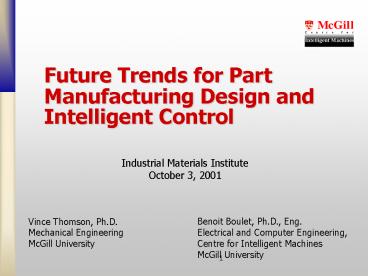Future Trends for Part Manufacturing Design and Intelligent Control - PowerPoint PPT Presentation
Title:
Future Trends for Part Manufacturing Design and Intelligent Control
Description:
Future Trends for Part Manufacturing Design and Intelligent Control Industrial Materials Institute October 3, 2001 Benoit Boulet, Ph.D., Eng. Electrical and Computer ... – PowerPoint PPT presentation
Number of Views:72
Avg rating:3.0/5.0
Title: Future Trends for Part Manufacturing Design and Intelligent Control
1
Future Trends for Part Manufacturing Design and
Intelligent Control
Industrial Materials InstituteOctober 3, 2001
Benoit Boulet, Ph.D., Eng.Electrical and
Computer Engineering, Centre for Intelligent
MachinesMcGill University
Vince Thomson, Ph.D.Mechanical
EngineeringMcGill University
2
Outline
- 1- Control of forming processes
- 2- In-cycle and cycle-to-cycle control
- 3- Applicable control theories
- 4- Adaptive process and part design
- 5- Controller architecture
- 6- McGill/IMI collaborative research
3
1- Control of Forming Processes
- injection mouldingscrew velocity, ram
pressure, barrel temperature - blow
mouldingparison programming, temperature -
thermoformingsheet temperature
4
Current control technologies in forming Processes
Open-Loop Control - use model blindly to
predict process output Loose Control -
control action taken after a long sequence of
parts are made, based on a quality
report Feedback Control - control actions taken
in real-time based on measurements
5
Open-Loop Control - use model blindly to
predict process output
Uncertainty
Input Dist.
Controller
Reference
Output
G-1
G
Nominal Process Model
6
Loose Control - control action taken after a
long sequence of parts has been made, based on a
quality report
Uncertainty
Input Dist.
Controller
Reference
Output
K
G
Nominal Process Model
7
Feedback Control - control actions taken in
real-time based on measurements
Uncertainty
Input Dist.
Controller
Reference
Output
K
G
Nominal Process Model
8
2- In-cycle and Cycle-to-cycle Process Control
In-cycle control- sensor measurements and
corrective control actions are taken within a
cycle as the part is being made. Cycle-to-cycle
control- corrective control actions are taken in
between cycles.
9
3- Applicable Control Theories
Robust and optimal control- model-based (robust
H?)- in-cycle control Intelligent control
(neural nets, fuzzy logic, genetic algorithms)-
cycle-to-cycle control Learning control-
cycle-to-cycle control
10
Robust in-cycle model-based control
Typical feedback control systemkey issue is
controller robustness to model uncertainty
Uncertainty
Output dist./ Meas. noise
Input Dist.
Controller
reference
Meas. output
K
G
-
Process Model
11
General objectives of feedback control
- Stabilize an unstable process - Reduce the
effect of process disturbances - Reduce the
effect of model uncertainty (robustness)
12
Benefits of in-cycle process control
Reduction of scrap - variations in feed
material properties and machine parameters
compensated for in real time More opportunities
to improve quality - robust multivariable
control finds best tradeoff in process inputs for
optimal quality
13
Intelligent cycle-to-cycle control
Typical intelligent control systemkey issue is
to learn the model or the best controller
settings off-line or on-line
Output dist./ Meas. noise
Input Dist.
Controller
Process
Meas. output
K
P
reference
Pm
GA
NF
Process FE Model
Genetic optimizer
Neurofuzzy system
14
Cycle-to-cycle learning control
Learning control systemkey issue is to learn
the best process inputs from cycle to cycle
Output dist./ Meas. noise
Input Dist.
LearningController
Meas. output
K
P
reference
Process
Example Heater temperature profile in
thermoforming
15
4- Adaptive Process and Part Design
Objectives for moulded parts Faster new product
introduction (NPI)- improve learning
curve Resolving process contingencies Real-time
data mining- cycle-to-cycle design improvements
16
Objectives for moulded parts
Minimize cycle time- low-value parts must be
made FAST Maintain quality- thickness- surface
quality
17
Typical NPI process
Advanced geometry, feature analysis Forward
direction driven (QFD) - requirements ?
specifications ? process Proposed research
Backward direction driven - process ?
specifications
18
Resolving process contingencies
Process information is related one parameter at a
time - For net shaped parts, this is not
sufficient. - Systematic, simultaneous analysis
of many parameters required. Relate process
variation to product specifications in real-time
- resolving dynamic change between process and
part design
19
5- Control System Architecture
Requirements - high sampling rate (in-cycle
control) - simultaneous task execution - hard
real-time - integration of information streams
- multi-layered process decisions at different
levels
20
Single-computer, single-process control
architecture
21
Single-computer, multi-process control
architecture
control actuator
control actuator
sensor
sensor
- S
- en
- s
- o
- r
- C
- ont
- r
- o
- l
process
process
process
single processor computer
22
Multi-computer, multi-process control
architecture
control actuator
control actuator
sensor
sensor
- S
- en
- s
- o
- r
- C
- ont
- r
- o
- l
shared data storage(shared memory)
23
6- McGill/IMI Collaborative Research
Advanced control of forming processes - 4-year
research program - 1.2M proposal to NRC/NSERC
RPP - Research Topics modeling, robust
control, intelligent control, in-cycle,
cycle-to-cycle, control architecture, etc. -
Target 4 Ph.D. students and 4 M.Eng. students to
work with IMI staff - Industrial partners -
Prototype controllers will be developed.
24
Thank you!































